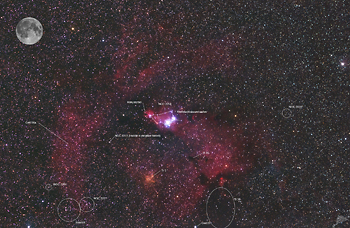 |
CHAMÄLEON + ONJALA OBSERVATORY DeepSky | SITEMAP HOME CHAMÄLEON |
|
 |
|||
| « back to overview Nebulae | Load higher resolution (1800 x 1200 Pixel 3500 x 2300 Pixel) | Object description |

The number 2264 from the NGC catalogue describes a region consisting of a H-II star forming region with a dark cloud in front of it, the Cone Nebula, a young open star cluster (the Christmas Tree Cluster) and blue diffuse reflection nebulae. The individual objects are located at a distance of between 2400 and 2700 light years from the Solar System. NGC 2264 can be found in the constellation Unicorn.
In many publications individual components of this region are often wrongly named. The NGC catalogue refers to the whole region as NGC 2264 and not only the H-II nebula region.
NGC 2261 - Hubbles variable nebula
NGC 2261 is a reflection nebula of variable shape and brightness, located about 2600 light years away from the sun. The nebula is illuminated by a young giant star of the spectral type B0 called R Monocerotis (R Mon). These changes occur in short time intervals of only a few weeks. The nebula got its additional name by Edwin Hubble, who studied the nebula in detail at the beginning of the last century.
The explanation for the variability of the nebula is that dense clouds of opaque dust pass close to R Monocerotis and cast shadows on the reflecting dust of the nebula, which become visible in the nebula.
 |
Trumpler 5 Trumpler 5, with an estimated age of 1.2 billion years, is a Methusalem among the open star clusters. It has an apparent diameter of 7 arc minutes and is far behind NGC 2264 with a distance of about 7,500 light years. The brightest stars are in the 17th magnitude class. Due to the high age of the individual stars the star cluster appears clearly red to gold colored. Trumpler 5 must have had a breathtaking sight at a young age at about 300 to 400 million years. Furthermore, our wide-angle view shows the open star clusters NGC 2251, 2254 and 2265, as well as Basel 8. NGC 2264 was discovered on January 18, 1784 and NGC 2261 on December 26, 1783 by Friedrich Wilhelm Herschel. « Labeled version with object names and a size comparison to the moon |
 |
 |
 |
 |
 |
 |
 |
| Sun | Moon | Solar System | DeepSky | Widefield | Miscellaneous | Spec. Projects |